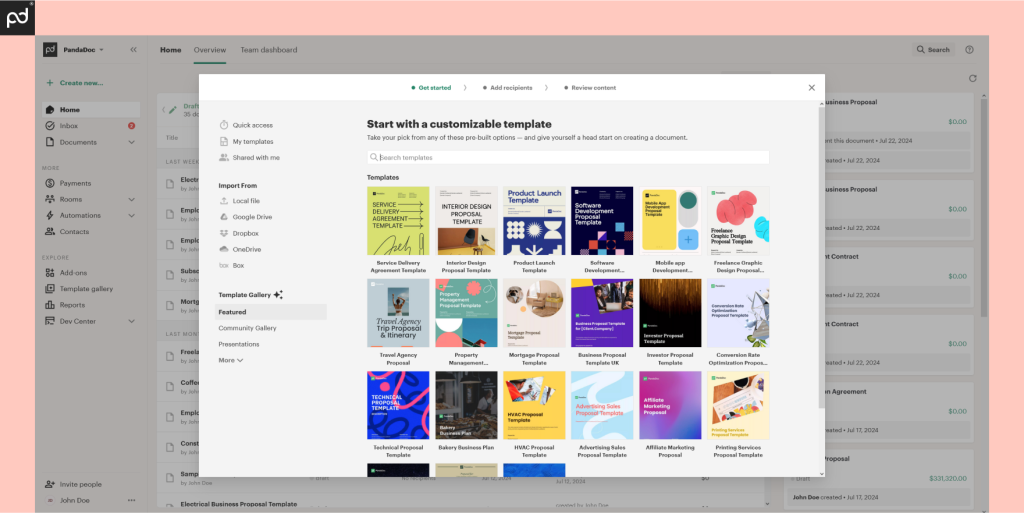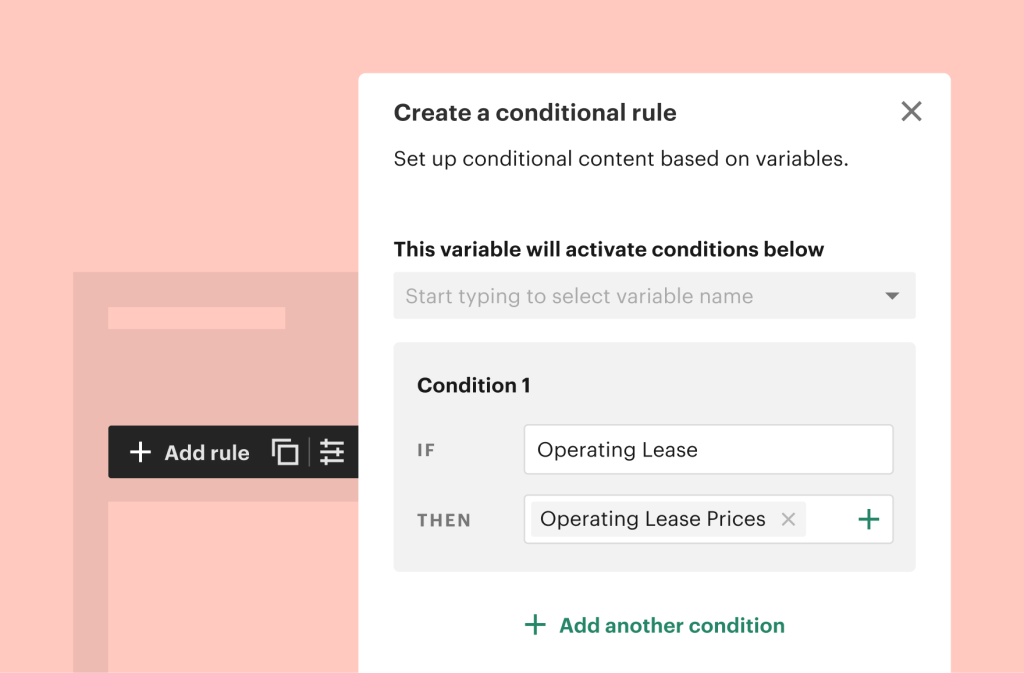Understanding the nuances of different leasing agreements is crucial for efficient financial management and asset acquisition.
Capital and operating leases are two primary types of lease agreements that businesses frequently use.
We’ll discuss the details of both capital and operating lease agreements, their benefits and applications in various industries, and demonstrate how PandaDoc’s innovative solutions can streamline the creation and management of these agreements.
What is a capital lease?
A capital lease, also known as a finance lease, is a long-term lease agreement where the lessee gains ownership of an asset by the end of the stated term.
Capital leases play a vital role in business operations.
They are instrumental in asset acquisition and financial management, offering businesses a way to manage large capital expenditures over time while benefiting from the use of essential equipment or machinery.
By categorizing the leased asset as both an asset and a liability on the balance sheet, capital leases also provide transparency in financial reporting.
Best practices for a capital lease agreement
When drafting a capital lease agreement, it is essential to include several key elements to ensure clarity, compliance, and protection for both parties.
The agreement should clearly define the lease term, including start and end dates, and specify the payment schedule, detailing amounts and due dates. It is crucial to include a detailed description of the leased asset, including its condition, maintenance responsibilities, and insurance requirements.
The agreement should outline the lessee’s option to purchase the asset at the end of the lease term, often for a nominal fee.
Additionally, ensure the inclusion of terms related to default and remedies, providing both parties with a clear understanding of their rights and obligations in case of non-compliance. By incorporating these elements, a capital lease agreement can effectively support the financial and operational objectives of the involved parties.
Industries commonly using capital lease agreements
Construction
In the construction industry, capital leases are useful for acquiring heavy machinery and equipment.
Companies often lease items like cranes, bulldozers, and excavators, which are critical for large-scale projects.
PandaDoc streamlines many processes for the construction industry, such creating business proposals, and construction contract management.
For example, a construction firm might enter into a capital lease agreement for a high-end excavator to use over several years, spreading the cost and preserving cash flow.
Manufacturing
Manufacturers frequently use capital leases to obtain industrial equipment and technology.
This allows them to keep up with technological advancements without the burden of upfront costs.
For instance, a manufacturing company might lease advanced CNC machines under a capital lease to enhance production capabilities and remain competitive in the market.
Service providers
Service providers, such as IT firms and transportation companies, benefit from capital leases for office equipment and vehicles.
An IT company might lease servers and networking equipment, ensuring they have the latest technology to support their services.
Similarly, a transportation company might lease a fleet of vehicles, optimizing operations and managing expenses efficiently.
While these industries commonly utilize these agreements, any business sector with similar needs could benefit from simplifying lease workflows.
Benefits of capital lease agreements
Capital leases offer many advantages. By leasing rather than purchasing, companies can:
- Preserve capital and improve cash flow.
- Benefit from potential tax deductions on lease payments.
- Maintain up-to-date equipment and technology.
- Reflect leased assets on the balance sheet, providing a clearer picture of financial health.
What is an operating lease agreement?
An operating lease is a short-term lease agreement where the lessor retains ownership of the asset, and the lessee uses it for a specified period.
Unlike capital leases, operating leases do not transfer ownership rights to the lessee by the end of the lease term.
Instead, the lessee enjoys the benefits of using the asset without the responsibilities and risks associated with ownership.
Operating leases are ideal for businesses that require temporary use of assets or those that frequently upgrade their equipment to stay competitive.
Best practices for an operating lease agreement
When drafting an operating lease agreement, it is crucial to include specific elements to ensure both parties are protected and fully understand their rights and responsibilities.
Start with a detailed description of the leased asset, including its condition, permitted use, and any restrictions on usage.
Clearly define the lease term, including commencement and expiration dates, and outline the payment schedule with amounts and due dates.
It’s important to specify maintenance and repair responsibilities, indicating which party is responsible for routine upkeep and any major repairs.
Include provisions for insurance, requiring the lessee to maintain adequate coverage to protect against damage or loss.
The agreement should address renewal and termination options, including any notice periods required for ending the lease early.
By incorporating these elements, an operating lease agreement can effectively provide clarity and protection, facilitating a smooth leasing arrangement for both lessor and lessee.
Industries using operating lease agreements
Construction
While construction companies often use capital leases for long-term heavy machinery, they also utilize operating leases for temporary equipment needs.
For instance, during peak project periods, a construction firm might lease additional scaffolding, generators, or specialized tools.
This allows them to scale up operations as needed without the long-term commitment of owning extra equipment.
Information Technology (IT)
The IT industry often relies on operating leases for acquiring new tech.
Companies lease servers, networking equipment, and office hardware, allowing them to upgrade to the latest technology without large upfront costs.
This ensures they remain competitive and efficient without the burden of outdated equipment.
Healthcare
In the healthcare industry, operating leases are common for medical equipment such as MRI machines, X-ray systems, and patient monitoring devices. Healthcare providers benefit from having access to the latest medical technology without the significant capital expenditure of purchasing these high-cost items.
This ensures that they can offer top-quality care to patients while effectively managing costs.
Benefits of operating lease agreements
Operating leases offer significant advantages to businesses, including:
- Lower monthly payments and avoidance of large upfront costs.
- The ability to upgrade or replace technology.
- Cleaner balance sheets by not recording leased assets as liabilities.
- Reduced responsibility for maintenance and upkeep, often handled by the lessor.
Key differences between operating leases and capital leases
While capital leases involve long-term commitments and transfer of ownership, operating leases are short-term and do not transfer ownership rights to the lessee.
Operating leases are typically used for assets that a business needs temporarily or those that are subject to rapid industry change.
Scenarios for each lease type
A capital lease is preferable when:
- The asset has a long useful life.
- The lessee intends to use the asset for most of its life and eventually gain ownership.
- The asset is crucial to the business’s operations and growth.
An operating lease is suitable when:
- The asset is needed for a short period.
- The asset is likely to become outdated sooner.
- The lessee wants to avoid the responsibility of ownership and maintenance.
Operating leases offer benefits such as lower monthly payments and the flexibility to upgrade assets more frequently.
However, they do not provide the same long-term financial benefits and asset ownership that capital leases do.
Creating capital and operating lease agreements at scale
Smart content and template creation

Managing capital and operating lease agreements can be complex. PandaDoc simplifies the process with easy-to-use features.
Our smart content and template creation tools enable you to design customized lease agreements that meet your needs.

By leveraging pre-built templates, you can save time and ensure consistency across all lease documents.
Conclusion
By understanding the benefits and applications of capital and operating leases, companies can make informed decisions that support their growth and operational efficiency.
PandaDoc offers the tools needed to create and manage these agreements easily, so you can focus on what you do best.
Explore PandaDoc’s solutions today and take the first step towards efficient lease management.
Disclaimer
PandaDoc is not a law firm, or a substitute for an attorney or law firm. This page is not intended to and does not provide legal advice. Should you have legal questions on the validity of e-signatures or digital signatures and the enforceability thereof, please consult with an attorney or law firm. Use of PandaDoc services are governed by our Terms of Use and Privacy Policy.

![Navigating the landscape of types of business contracts [+50 templates!]](https://public-site.marketing.pandadoc-static.com/app/uploads/sites/3/BP_types-of-business-contracts-339x176.png)
